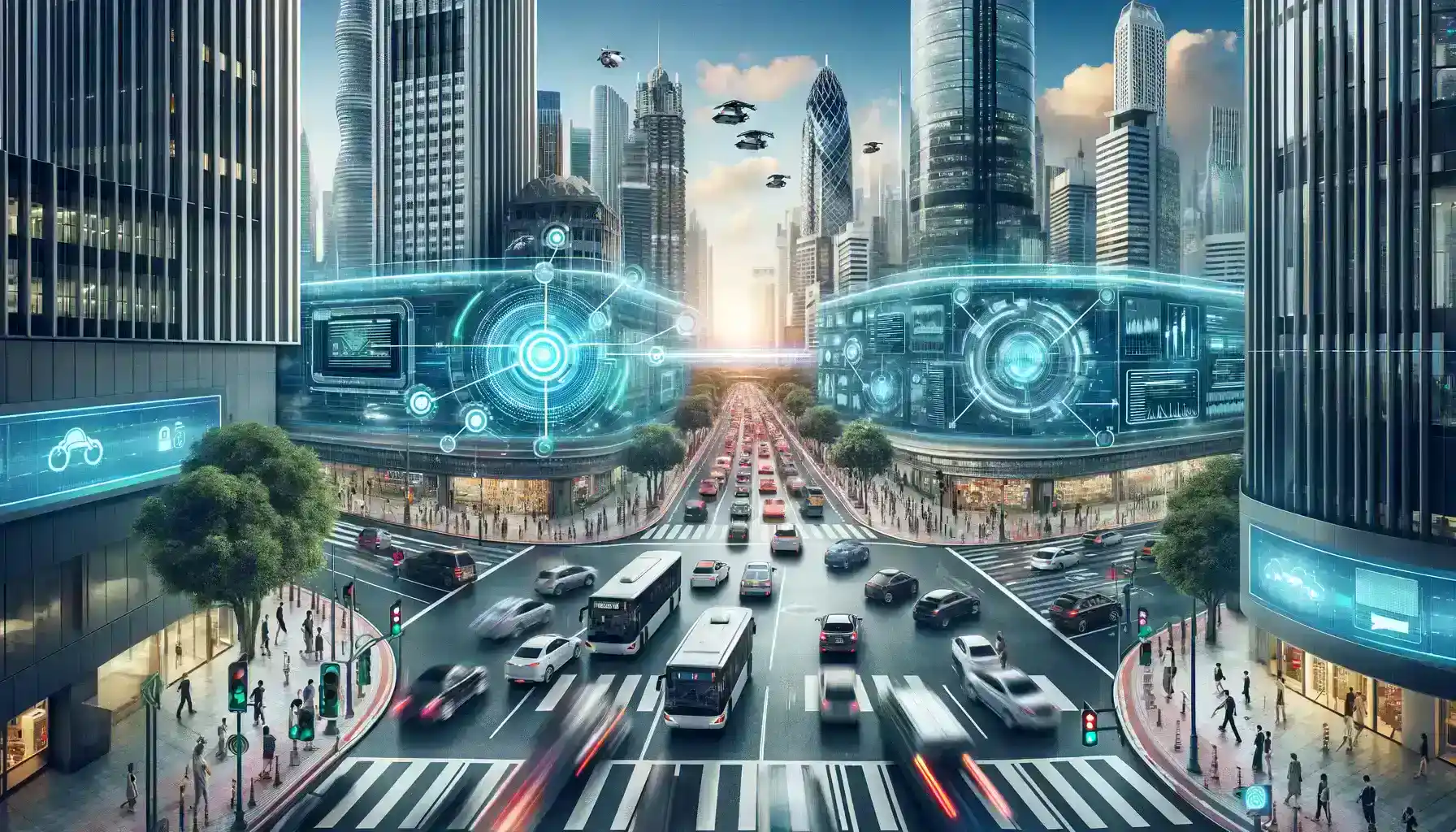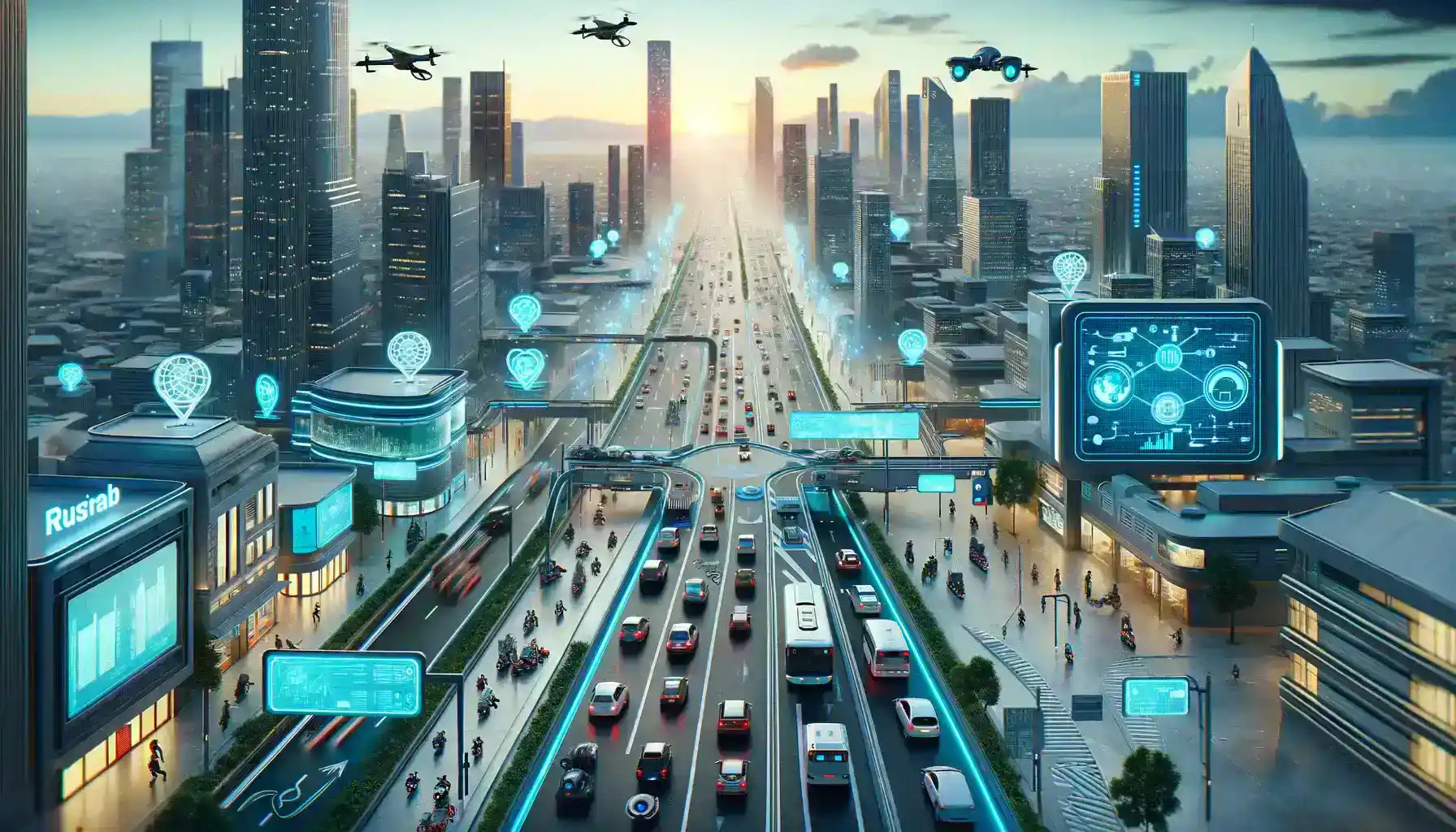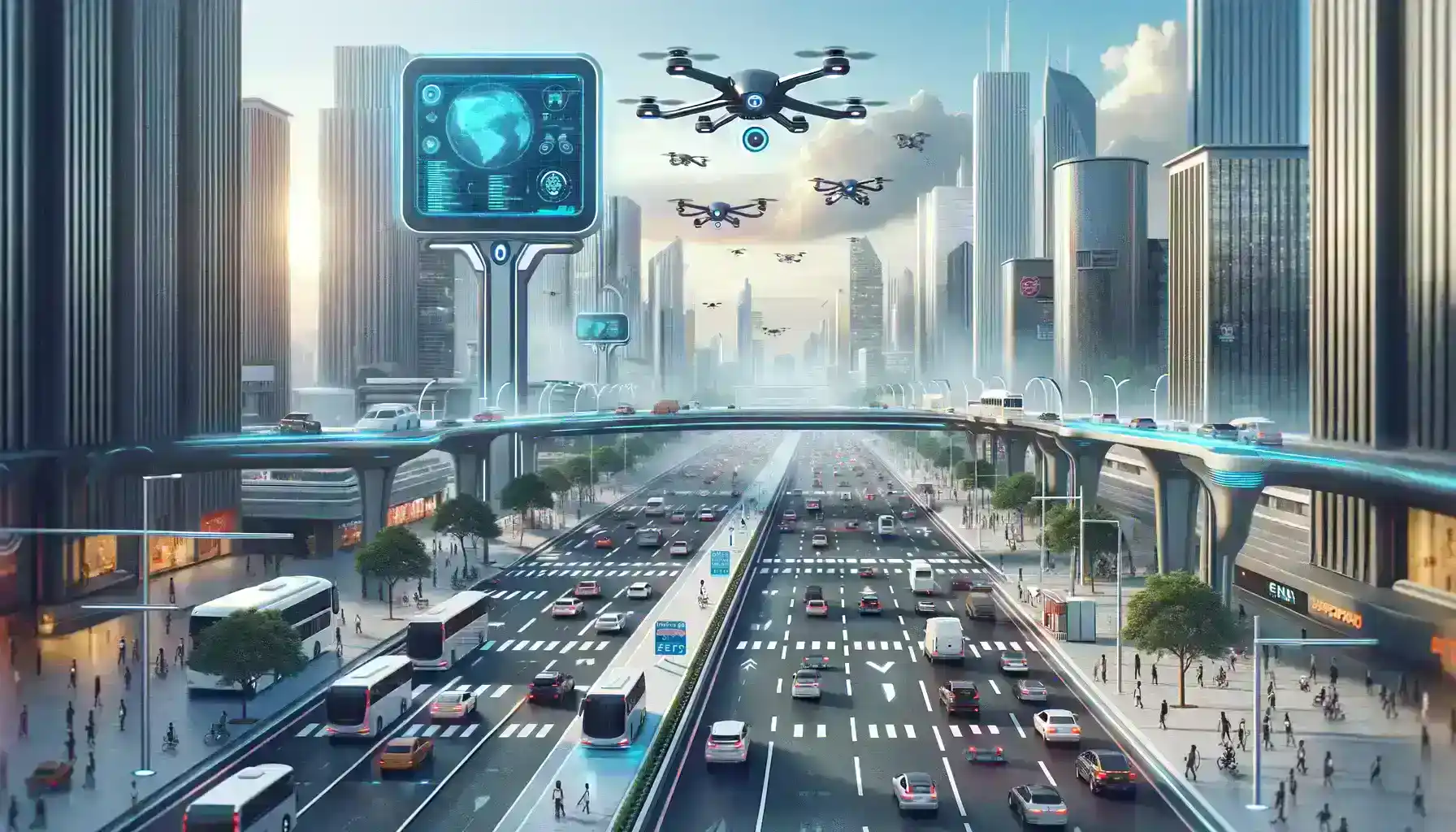Table of Contents
AI in traffic management involves the application of advanced computer algorithms, machine learning, and data analytics to optimize the flow of vehicles and pedestrians in urban areas. This means that AI uses sophisticated mathematical models and data-driven techniques to analyze and control traffic patterns.
Growing urban populations and increased vehicle ownership have led to severe traffic congestion in many cities. This congestion not only leads to frustration but also contributes to air pollution, longer commute times, and reduced quality of life for city residents.
Efficient traffic management can lead to cost savings, as less time and fuel are wasted in traffic jams. Moreover, cities with efficient transportation systems are more attractive to businesses and investors, boosting economic growth.
1. The Role of AI in Traffic Management
Artificial Intelligence (AI) is a branch of computer science that focuses on creating systems capable of performing tasks that typically require human intelligence. AI development services employ various techniques, including machine learning and deep learning, to enable systems to learn from data and make decisions or predictions.
Advantages of using AI in traffic management systems
- AI can make split-second decisions based on real-time data, ensuring efficient traffic flow and quick responses to incidents.
- AI optimizes traffic signal timings, route suggestions, and lane management to reduce congestion and travel times.
- AI systems can detect accidents, reckless driving, and hazards, enhancing road safety for both drivers and pedestrians.
- By minimizing stop-and-go traffic and optimizing routes, AI helps reduce fuel consumption and greenhouse gas emissions.
- AI in traffic management can improve overall city mobility, making transportation more accessible. For entrepreneurs looking to tap into this evolving sector, exploring various small business ideas related to AI and traffic management could be highly rewarding.
Copenhagen, Denmark, utilizes AI to manage its bicycle lanes and reduce cyclist congestion. As a result, cycling has become a more efficient and popular mode of transportation.

2. Traffic Flow Optimization
AI algorithms play a crucial role in optimizing traffic flow within a city. These algorithms leverage a wide range of data sources and computational power to make real-time decisions that improve traffic efficiency.
- AI algorithms collect and integrate data from various sources, including traffic sensors, GPS devices, weather forecasts, and historical traffic patterns. This data provides a comprehensive view of the current traffic situation.
- AI uses predictive analytics to anticipate traffic congestion and identify potential bottlenecks before they occur. This allows traffic management systems to take proactive measures to prevent gridlock.
- AI algorithms can dynamically adjust traffic signals and route vehicles to alleviate congestion. For example, when traffic starts building up on a particular route, AI can redirect vehicles to less congested roads, ensuring a more even distribution of traffic.
- AI can control traffic signals in real-time based on traffic conditions. For instance, if there’s a sudden surge of vehicles on one road, AI can prioritize green lights for that direction to reduce waiting times.
Sioux Falls in South Dakota utilizes AI to optimize traffic signal timings. This has resulted in a 15% reduction in travel times and a 25% decrease in fuel consumption, benefiting both commuters and the environment.
3. Reducing Congestion
Traffic congestion is a significant challenge in urban areas worldwide, leading to wasted time, increased fuel consumption, and heightened stress levels for commuters. AI has emerged as a powerful tool to address this issue effectively.
- AI excels at optimizing traffic flow by continuously analyzing real-time data from various sources such as traffic cameras, GPS devices, and sensors embedded in road infrastructure.
- Dynamic traffic signal control involves the use of AI algorithms to adjust traffic signal timings in real-time based on the current traffic conditions. Traditional traffic signals operate on fixed schedules or timers, which can often lead to inefficient traffic flow during peak hours or in response to incidents like accidents or road closures.
- On the other hand, AI-driven dynamic traffic signal control constantly analyzes traffic data to determine the optimal timing for each signal at any given moment.
The Los Angeles Department of Transportation (LADOT) implemented an AI in traffic management system that reduced traffic congestion by up to 16% in certain areas. By using predictive analytics, the system could anticipate traffic patterns and adjust signal timings accordingly.

4. Improving Safety
Road safety is a critical aspect of AI in traffic management, and AI plays a significant role in enhancing safety through the detection of accidents and hazards, as well as in the development of autonomous vehicles.
- AI algorithms, coupled with cameras and sensors installed on traffic signals and along roadways, constantly monitor traffic conditions. These systems can quickly identify accidents, debris on the road, or other hazards.
- When an accident or hazard is detected, AI systems can instantly alert traffic control centers and emergency services. This rapid response can significantly reduce the time it takes for help to arrive at the scene.
- Fully autonomous vehicles, or self-driving cars, are equipped with a suite of sensors and AI technology that allows them to navigate the road safely. These vehicles can react faster than human drivers, making them less prone to errors caused by distraction or fatigue.
AI-based collision avoidance systems in vehicles have been shown to reduce rear-end collisions by up to 70%, according to a report by the Insurance Institute for Highway Safety (IIHS).
5. Environmental Benefits
Traffic congestion and inefficient traffic management can have a significant negative impact on the environment, contributing to increased emissions and poor air quality in urban areas.
- One of the primary ways AI contributes to the environmental benefits of AI in traffic management is by reducing vehicle emissions. Traditional traffic signal systems often rely on fixed timing, leading to unnecessary idling at red lights and stop-and-go traffic, which increases fuel consumption and emissions
- AI in traffic management systems can also optimize routes for vehicles, reducing overall travel time and fuel consumption. For instance, AI-powered navigation apps analyze real-time traffic data to provide drivers with the most efficient routes, avoiding congestion and delays.

- AI in traffic management can optimize public transportation systems. Smart buses and trains equipped with AI systems can adjust routes and schedules based on real-time demand and traffic conditions, reducing the number of vehicles on the road and improving overall transportation efficiency.
Barcelona has implemented AI systems to manage its public transportation network more efficiently. These systems have reduced the number of vehicles on the road and encouraged the use of electric buses, contributing to lower emissions and improved air quality.
6. Legal Documentation and Post-Accident Procedures
While AI helps reduce accidents through real-time monitoring and predictive analytics, legal documentation remains essential when incidents occur. After a collision, drivers must handle police reports, insurance claims, medical records, and settlement agreements, where understanding resources such as How Does a Car Accident Release Form Work becomes important for resolving claims and avoiding future disputes. As AI adoption grows, many of these post-accident processes are becoming digitized, with AI-powered platforms compiling reports from traffic cameras and vehicle data, improving accuracy, speeding up verification, and enhancing transparency across insurers, law enforcement, and legal professionals.
Challenges and Future Development
While AI has shown tremendous potential in transforming AI in traffic management, it is not without its challenges and limitations. Understanding these issues is crucial for the effective implementation of AI in traffic management:
- Data Privacy and Security: Collecting and processing massive amounts of data for AI systems can raise concerns about privacy and security. Ensuring that personal information is protected and data is not misused is a significant challenge.
- Infrastructure Integration: Many cities have outdated or incompatible infrastructure. Integrating AI systems into existing traffic management infrastructure can be costly and complex.
- Algorithm Bias: AI algorithms can inherit biases from the data they are trained on, potentially leading to unfair or discriminatory outcomes. It’s essential to address bias issues to ensure equitable AI in traffic management.
- Unpredictable Events: AI systems may struggle to handle truly unexpected events, such as natural disasters or large-scale protests, which can disrupt traffic patterns and require human intervention.

Future Developments and Advancements
- 5G and Edge Computing: The rollout of 5G networks and edge computing capabilities will enable faster data processing, allowing AI systems to respond in real-time to changing traffic conditions.
- Connected and Autonomous Vehicles (CAVs): The continued development and integration of CAVs will provide AI with more data sources, making AI in traffic management more effective. CAVs can communicate with each other and with infrastructure to optimize traffic flow.
- AI-Powered Traffic Prediction: Advanced AI algorithms will improve traffic prediction models, enabling better anticipation of congestion and accidents, and facilitating proactive management.
- Urban Planning Integration: Future developments may involve a tighter integration of AI into urban planning. This could result in city designs that are inherently more traffic-friendly, reducing the need for extensive management.
- Sustainable Transportation: AI can play a significant role in promoting sustainable transportation, such as encouraging the use of public transit or electric vehicles, thereby reducing emissions and congestion.
Conclusion
In the fast-paced, ever-expanding landscapes of our modern cities, the effective management of traffic has emerged as a critical challenge. As urban populations grow, so does the complexity of navigating our streets. In this pursuit of city efficiency, artificial intelligence (AI) has emerged as a powerful ally, offering innovative solutions to the age-old problem of traffic congestion.
The future of AI in traffic management holds immense promise. With the advent of 5G, the proliferation of connected and autonomous vehicles, and the refinement of traffic prediction models, we stand on the cusp of a new era in urban mobility. AI, combined with sustainable transportation solutions, has the potential to reshape cities into more livable, efficient, and environmentally friendly spaces.
AI in traffic management represents a dynamic frontier where technology meets the challenges of modern urban life. As we navigate the complexities of our bustling cities, let us do so with a vision of smarter, safer, and more sustainable urban spaces powered by the ever-advancing capabilities of artificial intelligence. The future of city efficiency is on the horizon, and with AI as our ally, we can make our urban dreams a reality.